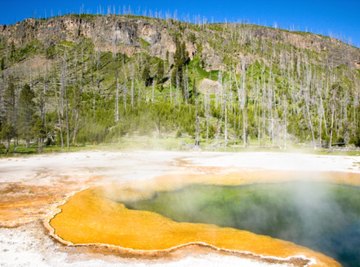
Hydrothermal deposits are combinations of stone and metal ores that occur when water with a significant amount of brine, or a salt component, comes into contact with a heat source such as magma. The presence of salt in the water and a significant amount of metals or minerals is required for hydrothermal deposits to form. These deposits are divided into three classes — hypothermal, mesothermal and epithermal — and may be further classified by whether ores form by replacement or by filling open spaces in rocks.
Conditions for Formation
In order for hydrothermal deposits to form, four conditions must be met: presence of briny, hot water with a high mineral content, presence of openings in rock to allow solutions to move, availability of a deposit site and a chemical reaction to make the deposit occur. Magma is the most common heat source, but metamorphic, meteoric or marine conditions may also facilitate a sufficient rise in temperature for these deposits to form. Hydrothermal deposits can form in any type of rock with deposition influenced by local rock formation. The final composition of the deposits is dependent upon the reaction between the briny solutions and the rocks with which they come into contact.
Brine is Essential
Pure water is never involved in hydrothermal formation but must contain brine. These brines, however, are different than seawater as they are able to dissolve and transport metals such as gold and silver. Brines, particularly those composed of sodium and calcium, are also effective solvents of sulfide and oxide minerals. They often contain magnesium and potassium salts, and small amount of many other elements. Concentrations range from a few percent of dissolved solids by weight to as much as 50 percent.
Mesothermal Deposits
These deposits are characterized by both replace and open space textures, the latter of which is more common at shallower depths. Sharper contact with native rocks, which my be igneous, sedimentary or metamorphic, is also common. The most abundant minerals are chalcopyrite, bornite, enargit, tetrahedrite, sphalerite and galena. Base metals are usually lead, zinc and copper.
Epithermal Deposits
Also known as shallow heat deposits, this type is commonly associated with hot springs and geysers, thus making them the most well known type of hydrothermal deposits. Open space filling, characterized by crusting, combing and symmetrical bands, is the most common type of formation. A wide variety of ores are found in these deposits, most commonly gold and sulfide ores such as copper, zinc lead, molybdenum, bismuth, nickel, cobalt, antimony and mercury. Minerals associated in these veins include quartz, calcite, fluorite, barite, chalcedony, rhodochrosite and dolomite.
References
Resources
Photo Credits
Jupiterimages/Photos.com/Getty Images
